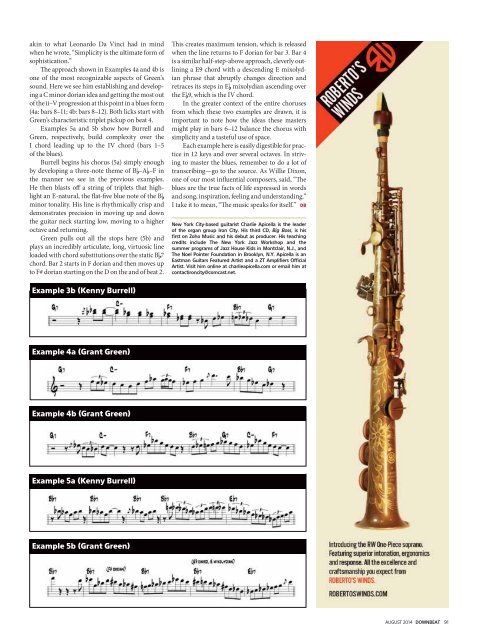You also want an ePaper? Increase the reach of your titles
YUMPU automatically turns print PDFs into web optimized ePapers that Google loves.
akin to what Leonardo Da Vinci had in mind<br />
when he wrote, “Simplicity is the ultimate form of<br />
sophistication.”<br />
The approach shown in Examples 4a and 4b is<br />
one of the most recognizable aspects of Green’s<br />
sound. Here we see him establishing and developing<br />
a C minor dorian idea and getting the most out<br />
of the ii–V progression at this point in a blues form<br />
(4a: bars 8–11; 4b: bars 8–12). Both licks start with<br />
Green’s characteristic triplet pickup on beat 4.<br />
Examples 5a and 5b show how Burrell and<br />
Green, respectively, build complexity over the<br />
I chord leading up to the IV chord (bars 1–5<br />
of the blues).<br />
Burrell begins his chorus (5a) simply enough<br />
by developing a three-note theme of B♭–A♭–F in<br />
the manner we see in the previous examples.<br />
He then blasts off a string of triplets that highlight<br />
an E-natural, the flat-five blue note of the B♭<br />
minor tonality. His line is rhythmically crisp and<br />
demonstrates precision in moving up and down<br />
the guitar neck starting low, moving to a higher<br />
octave and returning.<br />
Green pulls out all the stops here (5b) and<br />
plays an incredibly articulate, long, virtuosic line<br />
loaded with chord substitutions over the static B♭7<br />
chord. Bar 2 starts in F dorian and then moves up<br />
to F# dorian starting on the D on the and of beat 2.<br />
This creates maximum tension, which is released<br />
when the line returns to F dorian for bar 3. Bar 4<br />
is a similar half-step-above approach, cleverly outlining<br />
a E9 chord with a descending E mixolydian<br />
phrase that abruptly changes direction and<br />
retraces its steps in E♭ mixolydian ascending over<br />
the E♭9, which is the IV chord.<br />
In the greater context of the entire choruses<br />
from which these two examples are drawn, it is<br />
important to note how the ideas these masters<br />
might play in bars 6–12 balance the chorus with<br />
simplicity and a tasteful use of space.<br />
Each example here is easily digestible for practice<br />
in 12 keys and over several octaves. In striving<br />
to master the blues, remember to do a lot of<br />
transcribing—go to the source. As Willie Dixon,<br />
one of our most influential composers, said, “The<br />
blues are the true facts of life expressed in words<br />
and song, inspiration, feeling and understanding.”<br />
I take it to mean, “The music speaks for itself.” DB<br />
New York City-based guitarist Charlie Apicella is the leader<br />
of the organ group Iron City. His third CD, Big Boss, is his<br />
first on Zoho Music and his debut as producer. His teaching<br />
credits include The New York Jazz Workshop and the<br />
summer programs of Jazz House Kids in Montclair, N.J., and<br />
The Noel Pointer Foundation in Brooklyn, N.Y. Apicella is an<br />
Eastman Guitars Featured Artist and a ZT Amplifiers Official<br />
Artist. Visit him online at charlieapicella.com or email him at<br />
contactironcity@comcast.net.<br />
Example 3b (Kenny Burrell)<br />
Example 4a (Grant Green)<br />
Example 4b (Grant Green)<br />
Example 5a (Kenny Burrell)<br />
Example 5b (Grant Green)<br />
AUGUST 2014 DOWNBEAT 91


